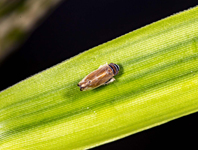Abstract
Trypanosoma rangeli Tejera, 1920 is peculiar in being transmitted to mammal hosts through the bite of triatomine bugs. For this reason, it has been placed in its own subgenus, Tejeraia Añez, 1982. This name is a junior homonym of Tejeraia Díaz-Ungría, 1963, used for the roundworm Tejeraia mediospiralis (Molin, 1860). The mandatory substitute name of Tejeraia Añez, 1982 is Aneza Özdikmen, 2009. T. (Aneza) rangeli Tejera, 1920 is often referred to as T. (Herpetosoma) rangeli Tejera, 1920. According to nomenclature rules, both name combinations are available. Which one to choose depends on evolutionary and taxonomic considerations. Phylogenetic knowledge indicates that T. (Aneza) rangeli should be used.
References
Añez, N. (1982) Studies on Trypanosoma rangeli Tejera, 1920. IV—A reconsideration of its systematic position. Memórias do Instituto Oswaldo Cruz, 77, 405–415.
https://doi.org/10.1590/S0074-02761982000400007Díaz-Ungría, C. (1963) Nématodes parasites, nouveaux ou intéressants, du Vénézuéla. Annales de Parasitologie, 38, 893–914.
https://doi.org/10.1051/parasite/1963386893Dubois, A. (2007) Genitives of species and subspecies nomina derived from personal names should not be emended. Zootaxa, 1550, 49–68.
Fraga, J., Fernández-Calienes, A., Montalvo, A.M., Maes, I., Deborggraeve, S., Büscher, P., Dujardin, J.-C. & Van der Auwera, G. (2016) Phylogenetic analysis of the Trypanosoma genus based on the heat-shock protein 70 gene. Infection, Genetics and Evolution, 43, 165–172.
https://doi.org/10.1016/j.meegid.2016.05.016Gibson, W. (2016) Kinetoplastea. In: Archibald, J.M., Simpson, A.G.B., Slamovits, C.H., Margulis, L., Melkonian, M., Chapman, D.J. & Corliss, J.O. (Eds.), Handbook of the Protists. Springer, Cham, pp. 1–50.
https://doi.org/10.1007/978-3-319-32669-6_7-1Guhl, F. & Vallejo G.A. (2003) Trypanosoma (Herpetosoma) rangeli Tejera, 1920—an updated review. Memórias do Instituto Oswaldo Cruz, 98, 435–442.
https://doi.org/10.1590/S0074-02762003000400001Hoare, C.A. (1964) Morphological and taxonomic studies on mammalian trypanosomes. X. Revision of the systematics. Journal of Protozoology, 2, 200–207.
https://doi.org/10.1111/j.1550-7408.1964.tb01741.xHoare, C.A. (1968) Morphological and taxonomic studies on mammalian trypanosomes. XI. The systematic position of Trypanosoma rangeli. In: Anselmi, A. (Ed.), Medicina Tropical. Editorial Fournier, México, pp. 276–290.
Hughes, A.L. & Piontkivska, H. (2003) Phylogeny of Trypanosomatidae and Bodonidae (Kinetoplastida) based on 18S rRNA: evidence for paraphyly of Trypanosoma and six other genera. Molecular Biology and Evolution, 20, 644–652.
https://doi.org/10.1093/molbev/msg062ICZN, International Commission on Zoological Nomenclature (1999) International Code of Zoological Nomenclature, Fourth Edition. International Trust for Zoological Nomenclature, London, 306 pp.
Lin, R.H., Lai, D.H., Zheng, L.L., Wu, J,, Lukeš, J., Hide, G. & Lun, Z.R. (2015) Analysis of the mitochondrial maxicircle of Trypanosoma lewisi, a neglected human pathogen. Parasites & Vectors, 8, 665.
https://doi.org/10.1186/s13071-015-1281-8Maia da Silva, F., Junqueira, A.C.V., Campaner, M., Rodrigues, A.C., Crisante, G., Ramírez, L.E., Caballero, Z.C., Monteiro, F.A., Coura, J.R., Añez, N. & Teixeira, M.M.G. (2007) Comparative phylogeography of Trypanosoma rangeli and Rhodnius (Hemiptera: Reduviidae) supports a long coexistence of parasite lineages and their sympatric vectors. Molecular Ecology, 16, 3361–3373.
https://doi.org/10.1111/j.1365-294X.2007.03371.xMaia da Silva, F., Noyes, H., Campaner, M., Junqueira, A.C.V., Coura, J.R., Añez, N., Shaw, J.J., Stevens, J.R. & Teixeira, M.M. (2004) Phylogeny, taxonomy and grouping of Trypanosoma rangeli isolates from man, triatomines and sylvatic mammals from widespread geographical origin based on SSU and ITS ribosomal sequences. Parasitology, 129, 549–561.
https://doi.org/10.1017/S0031182004005931Molinari, J. & Moreno, S.A. (2018) Trypanosoma brucei Plimmer Bradford, 1899 is a synonym of T. evansi (Steel, 1885) according to current knowledge and by application of nomenclature rules. Systematic Parasitology, 95, 249–256.
https://doi.org/10.1007/s11230-018-9779-zMoore, R.C., Weller, J.M. & Knight, J.B. (1942) Erroneous emendation of generic names. Journal of Paleontology, 16, 250–261.
Özdikmen, H. (2009) Substitute names for some unicellular animal taxa (Protozoa). Munis Entomology & Zoology Journal, 4, 233–256.
Smales, L.R. (2004) Spirosprattus scyphiformis n. g., n. sp. (Nematoda: Spirurida), from the Cape York Rat, Rattus leucopus (Gray, 1867) (Rodentia: Muridae), in Cape York, Australia. Comparative Parasitology, 71, 184–189.
https://doi.org/10.1654/4108Stevens, J.R. & Brisse, S. (2004) Systematics of trypanosomes of medical and veterinary importance. In: Maudlin, I., Holmes, P.H. & Miles, M.A. (Eds.), The trypanosomiases. CABI Publishing, Cambridge, MA, pp. 1–23.
https://doi.org/10.1079/9780851994758.0001Stevens, J.R., Teixeira, M.M.G., Bingle, L.E.H. & Gibson, W.C. (1999) The taxonomic position and evolutionary relationships of Trypanosoma rangeli. International Journal for Parasitology, 29, 749–757.
https://doi.org/10.1016/S0020-7519(99)00016-8

